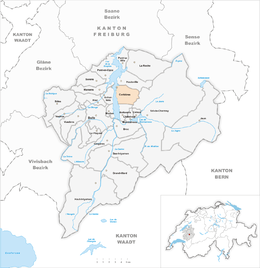Corbières, Gruyère
| Corbières | ||
|---|---|---|
 |
||
|
||
| Coordinates: 46°40′N 7°6′E / 46.667°N 7.100°ECoordinates: 46°40′N 7°6′E / 46.667°N 7.100°E | ||
| Country | Switzerland | |
| Canton | Fribourg | |
| District | Gruyère | |
| Government | ||
| • Mayor | Syndic | |
| Area | ||
| • Total | 9.6 km2 (3.7 sq mi) | |
| Elevation | 714 m (2,343 ft) | |
| Population (Dec 2015) | ||
| • Total | 839 | |
| • Density | 87/km2 (230/sq mi) | |
| Postal code | 1647 | |
| SFOS number | 2129 | |
| Surrounded by | Cerniat, Echarlens, Hauteville, Marsens, Villarvolard | |
| Website |
http://www.corbieres.ch SFSO statistics |
|
Corbières is a municipality in the district of Gruyère in the canton of Fribourg in Switzerland. On 1 January 2011 the former municipality of Villarvolard merged into the municipality of Corbières.
Corbières is first mentioned around 1115 as Corbere. The municipality was formerly known by its German name Korbers, however, that name is no longer used.
Corbières has an area, as of 2009[update], of 4.2 square kilometers (1.6 sq mi). Of this area, 2.2 km2 (0.85 sq mi) or 53.0% is used for agricultural purposes, while 1.64 km2 (0.63 sq mi) or 39.5% is forested. Of the rest of the land, 0.31 km2 (0.12 sq mi) or 7.5% is settled (buildings or roads) and 0.01 km2 (2.5 acres) or 0.2% is unproductive land.
Of the built up area, housing and buildings made up 4.3% and transportation infrastructure made up 1.9%. Out of the forested land, 35.4% of the total land area is heavily forested and 4.1% is covered with orchards or small clusters of trees. Of the agricultural land, 1.0% is used for growing crops and 18.3% is pastures and 33.7% is used for alpine pastures.
The municipality is located in the Gruyère district, on the right bank of the Saane river. It consists of the village of Corbières on the Fribourg-Bulle road.
The blazon of the municipal coat of arms is Gules, on a Bend Argent a Crow Sable passant.
Corbières has a population (as of December 2015[update]) of 839. As of 2008[update], 6.2% of the population are resident foreign nationals. Over the last 10 years (2000–2010) the population has changed at a rate of 18%. Migration accounted for 15.5%, while births and deaths accounted for 4.8%.
...
Wikipedia



